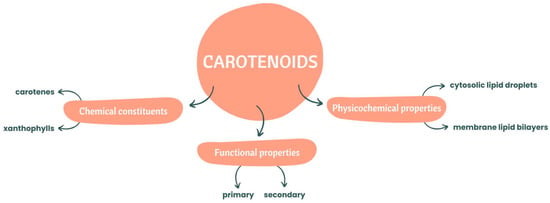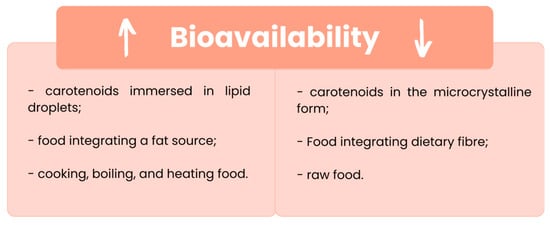You're using an outdated browser. Please upgrade to a modern browser for the best experience.
Please note this is a comparison between Version 1 by Manuela Pintado and Version 2 by Conner Chen.
The bioaccessibility of a carotenoid is defined as the maximum quantity of a carotenoid released from the food matrix that is available to be absorbed in the epithelial cells of the intestine [33]. The fraction of an ingested compound that enters the bloodstream and performs its physiological functions is the definition of the bioavailability of a carotenoid.
- carotenoids
- gastrointestinal tract
- intestinal microbiota
1. Introduction
Carotenoids are natural pigments from the tetraterpenes family, characterized by a central chain with 40 atoms of carbon and alternating single and double bonds and various cyclic or acyclic end groups, depending on the carotenoid [1]. In terms of physicochemical properties, carotenoids are colourful lipophilic compounds [1][2][1,2], responsible for the variety of colours present in several autotrophs such as microalgae, bacteria, fungi, and plants [1][3][1,3].
Humans and animals cannot synthesize carotenoids by themselves, they can be found in their tissues due to the absorption and deposition of the carotenoids ingested in dietary food [2][4][5][2,4,5].
Carotenoids are natural organic pigmented compounds with structural variations, with more than 750 carotenoids being known, but only 40 of them are present in the human diet and 20 in human blood and tissues [1][6][7][8][1,6,7,8]. The 40 carotenoids present in a usual human diet [1] can be found in coloured fruits and vegetables, such as tomatoes, carrots, and spinach [9].
In terms of chemical constituents, these natural pigments can be divided into two categories: carotenes and xanthophylls [10]. If they are pure hydrocarbons, they can be classified as carotenes such as alpha(α)-carotene, beta(β)-carotene, and lycopene [8]. Xanthophylls are carotenoids with oxygenated derivatives on their terminal rings [8], with complex xanthophylls containing oxygen substituents, aldehyde groups, epoxide groups and oxo/keto groups [11]. Zeaxanthin, lutein, canthaxanthin, violaxanthin and neoxanthin are examples of complex xanthophylls.
Carotenes absorb light energy from chlorophyll and energy from singlet oxygen formed in photosynthesis, being responsible for transmitting this light and protecting the plant tissues [5]. Xanthophylls, synthesized within the plastids, work as accessory pigments, capturing the wavelengths of sunlight that chlorophyll cannot absorb [5].
Regarding functional properties, carotenoids can be classified as primary and secondary carotenoids, with the photosynthetic ones included in the primary group and playing an important role in photosynthesis [2][12][2,12].
These natural organic pigmented compounds, in terms of physicochemical properties, are associated with membrane lipid bilayers and cytosolic lipid droplets, which can affect some properties associated with the permeability and fluidity of the membrane [9].
The principal properties of carotenoids mentioned before are illustrated below, in Figure 1.

Figure 1.
Chemical constituents and functional and physicochemical properties of carotenoids.
The regular consumption of fruits and vegetables is widely recommended due to their multiple health benefits such as the lower incidence of chronic diseases [13] such as cardiovascular diseases (CVDs), several types of cancers [14], and bowel diseases. Chron’s disease and ulcerative colitis are two chronic inflammatory bowel diseases (IBDs) characterized by recurring episodes of inflammation in the gastrointestinal tract (GIT) [15] that cause damage to its tissues [16].
Several studies have attributed to bioactive compounds present in the diet [14], in particular carotenoids [13][17][13,17], the responsibility for beneficial health effects in various pathologies, namely IBDs. This can be explained by their several important biological functions such as antioxidant activity [2][18][2,18], meaning that these pigments can inhibit or downregulate the unstable compounds produced by the body [2][18][2,18] in various pathologies and during oxidative stress caused by reactive oxygen species (ROS) [1][19][1,19]. In addition to this, carotenoids have other important functions such as antibacterial, immunological, and anti-inflammatory activity, and beneficial effects on the treatment of diabetes, and in infectious, eye, and neurological diseases [2][18][2,18].
Some of the more important biological functions related to human health of the three most known carotenoids are presented in Table 1.
Table 1.
Principal biological functions of β-carotene, lutein, and lycopene.
| Carotenoid | Biological Functions | References |
|---|---|---|
| β-carotene | Stimulates the proliferation of lymphocytes; reduces the low-density lipoprotein (LDL) susceptibility to oxidation; activates cell communication; reduces inflammation; improves cardiovascular health. |
[2][20][21][2,20,21] |
| Lutein | Scavenges oxygen intermediates; blue light filter; maintenance of eye health; decreases the proliferation of breast cancer cells; reduces oxidative stress and apoptosis. |
[1][21][22][23][24][1,21,22,23,24] |
| Lycopene | Inhibits lipid peroxidation; eliminates reactive oxygen species (ROS); reinforces the immune system; free radical quencher; prevents skin damage. |
[2][21][2,21] |
These antioxidant phytochemicals are also important dietary sources of vitamin A and protect cells and tissues from oxidative damage, interacting with other antioxidants [11][25][11,25]. So far, only 50 carotenoids are known to have provitamin A activity [12], with α-carotene, β-carotene, gamma(γ)-carotene, and β-cryptoxanthin being the most important precursors of vitamin A in humans [12][20][12,20].
Vitamin A is important for proper visual, immune, and gastrointestinal functions, growth, and embryonal development [20]. Humans cannot synthesize vitamin A de novo, obtaining adequate amounts through dietary food, such as from orange and yellow vegetables and in vegetables with dark green leaves [20].
The recent discoveries about the health promotion properties of carotenoids have aroused interest in applying these natural pigments in diversified areas [2]. These natural pigments have several applications such as in feed, and in the food, nutraceutical, and pharmacology industries [5]. Carotenoids can be applied as colourants in food, beverages, and cosmetics, as food supplements, as feed additives, and as supplements [26].
In nature, the bioavailability of carotenoids is reduced [1][20][1,20] without processing or any type of treatment, leading to an accumulation in the colon [27], which is colonized by a large number of microorganisms [28] that play important roles in digestion and metabolism [29], as well as in maintaining normal gut physiology and health [30].
Diet is one of the most important regulators of the intestinal microbiota [31], but there is a lack of information about the relationship between carotenoids and the intestinal microbiota [32]. In addition to that, these natural pigments are hydrophobic molecules, which makes their solubility in water low and, when exposed to light, heat, oxygen, or acids, are very susceptible to multiple oxidation and isomerisation reactions [5]. Therefore, the polarity of carotenoids can change due to the polar functional groups attached to the main chain and some products with harmful or unknown effects can also be formed [1], which can affect the carotenoids’ bioaccessibility, bioavailability, and absorption.
2. Bioaccessibility and Bioavailability of Carotenoids
The bioaccessibility of a carotenoid is defined as the maximum quantity of a carotenoid released from the food matrix that is available to be absorbed in the epithelial cells of the intestine [33]. The fraction of an ingested compound that enters the bloodstream and performs its physiological functions is the definition of the bioavailability of a carotenoid [5][34][5,34]. In nature, the bioavailability of these natural pigments is reduced, since there is a resistance to digestion and degradation from the protein complexes of carotenoids and the cell walls of plants to achieve adequate release from the matrix [1][20][1,20]. In the case of β-carotene, the activity and conversion to vitamin A are high. However, the absorption from plant sources is approximately 65%, with the recommended daily intake of 2–4 mg per day not being achieved [20][35][20,35]. The carotenoids’ bioavailability and consequently absorption have some limitations due to factors such as the dietary sources, food composition, cooking temperature, season, the breakup of the food matrix, presence of lipids, dosage, and presence of other soluble compounds/carotenoids [18][36][18,36]. These factors can lead to the release of carotenoids from the food matrix, improving its bioavailability or transforming the carotenoids into isomers that are better absorbed by the organism [36]. The release from the food matrix depends on the state of the carotenoid, as natural pigments immersed entirely in lipid droplets are more easily released than ones in the microcrystalline form [37]. This explains the low availability of lycopene in tomatoes and β-carotene in carrots [37]. The dietary composition also has a significant effect on the bioavailability of carotenoids [36]. Carotenoids are lipophilic compounds and for this reason their bioavailability increases when they are consumed allied with a fat source [38], but decreases when they are consumed with dietary fibre such as pectin [39]. Food thermal processes such as cooking, boiling, and heating disrupt the cellular membrane, allowing the release of carotenoids from the matrix [1][20][21][1,20,21], and although this leads to a decrease in the carotenoid content, it raises their bioavailability and absorption when compared with uncooked food [1][8][20][1,8,20]. For example, in cooked tomatoes, the lycopene availability is higher than in raw tomatoes, and the more prolonged the heat treatment, the lower the carotenoid content is [21]. The principal factors affecting the carotenoids’ bioavailability, enhancing (left) or decreasing (right) it, are represented below, in Figure 2.
